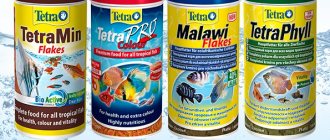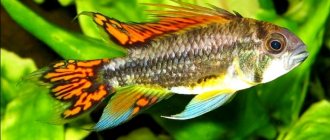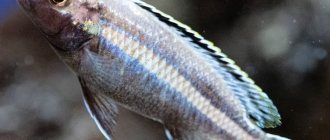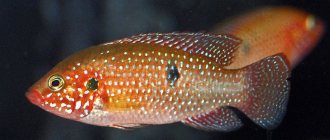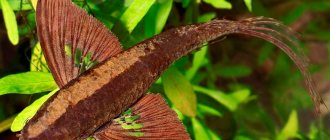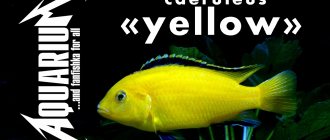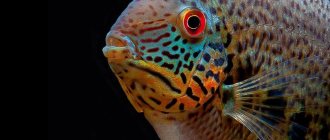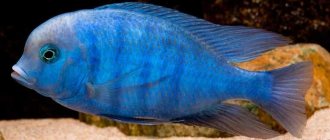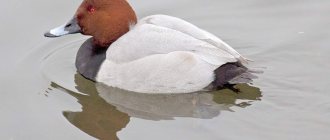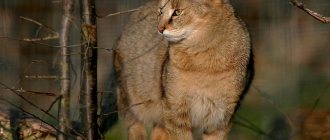Ramirezi's apistogram (lat. Mikrogeophagus ramirezi) or butterfly cichlid (chromis butterfly), is a small, beautiful, peaceful aquarium fish that has many different names. Although it was discovered 30 years later than its relative the Bolivian butterfly (Mikrogeophagus altispinosus), it is the Ramiresi apistogram that is now more widely known and widely sold. Although both of these cichlids are dwarf, the butterfly is smaller in size than the Bolivian butterfly and grows up to 5 cm, in nature it is slightly larger, about 7 cm.
Description
The butterfly will decorate the aquarium of experienced and amateur aquarists. Ramirezi fish are not suitable for beginner aquarists due to their sensitivity to water parameters.
Appearance
The body of the apistogram looks oval. The fish is small in size: up to 5 cm in an aquarium, in nature – up to 8 cm. The color is rich, they come in blue, olive and yellow colors. There is a pattern of shiny dots on the body, head and fins. Black stripes are located on the head and abdomen. The fins are high. The first rays of the dorsal fin are dark. Butterflies have large red eyes.
Character
The fish's temperament is peaceful, except during the spawning period. The apistogramma scares fish that invade its territory. Rarely attacks. Unlike other cichlids, Apistogramma do not damage plants.
Lifespan
In good conditions and at 26 degrees, ramirezi live up to 4 years. At 27–30 degrees they live up to 3 years. In cool water they are susceptible to diseases, so lowering the temperature does not always prolong the life of butterflies.
Reviews
Apistogramma Ramiresi is a beautiful fish with a luxurious color that can decorate any aquarium. You can watch the fish for hours. This is a universal individual that can get along with many inhabitants of the aquarium. It is not surprising that more and more aquarists are purchasing these original fish.
Want to buy a fish? Share in the comments!
Kinds
The tanks contain natural ramirezi and selection forms. The natural apistogram has increased immunity.
Ramiresi
The general color is yellowish, the forehead is red. More blue in color appears during spawning. A dark spot limits the eye. The abdomen is crimson or orange. The fins are translucent.
Electric blue
The apistogram is a rich turquoise color, the front part is red. The intensity of the colors of the ramiresi apistogram depends on the conditions of detention and light. The fins are bright neon. Lives for 2 years. It is also called ramiresi blue neon.
Ramirezi gold
Golden variety. Apistogramma gold is lemon-colored with turquoise sparkles on the sides and fins. The male has a reddish dorsal fin.
Balloon
A butterfly with a short body shape and a rounded belly. Due to severe deformation of the body, she often gets sick.
Compatibility
Despite the fact that their relatives are often distinguished by aggressive behavior, the apistogramma ramirezi is a peaceful fish that gets along well with similar gentle species. They are not like other cichlids. They do not have the habit of digging or damaging aquarium vegetation, making them an excellent option for a tropical home pond.
Viviparous, unpretentious fish, such as mollies, swordtails or guppies, will be excellent neighbors. They will also not offend neons, Rhodostomus rasbora and large shrimp. However, the fish fry will be mistaken for food, so in order to reproduce any species, the pair will have to be removed.
Content
Keeping and caring for butterflies is easier than other cichlids. They do not require a very large aquarium and are less picky. Take care of quality equipment, good filtration and aeration, proper proximity and diet.
Aquarium
The recommended aquarium volume for a pair of cichlids is from 40 liters. An 80-liter aquarium is enough for a small flock.
Priming
Place sand or fine gravel at the bottom; apistogrammas sometimes dig it. Sharp and large stones can injure the fish.
Water
Butterflies are demanding on water quality. Provide the fish with clean water; they do not tolerate cloudiness or sudden changes in parameters. In a 40–80 liter aquarium, change part of the water 1–2 times a week by 10–15%. In large tanks, change the fluid no more than once a week. Avoid strong water movement.
Optimal parameters.
| rigidity | 5–12 dGH (soft water) |
| acidity | 6.5–7.5 ph |
| water temperature | 26–30 degrees |
Lighting
The Apistogramma fish is unpretentious to light. Choose bright overhead lighting that will be comfortable for fish and plants. Make sure that the lamp does not heat the water too much. The colors of the fish are better revealed in the light of the cold spectrum. You can add a special lamp that enhances the color. Avoid incandescent lamps, their spectral composition and heat output are not suitable for an aquarium with apistograms.
Plants
Create shaded areas with floating plants:
- Riccia floating;
- duckweed;
- salvinia;
- hydrocotyls.
An aquarium with apistogramma contains any plants. Give preference to green plants:
- hornwort;
- elodea;
- Vallisneria in the aquarium;
- ferns;
- limnophils.
Red-leaved species (Ludwigia, Cryptocoryne) are undesirable; butterfly fish look less impressive with them.
Habitat arrangement
Place the necessary equipment:
- external or internal filter;
- compressor;
- heater.
View this post on Instagram
#Mikrogeophagus #ramirezi #male #guarding his #nest in our #losllanos #biotope in the #shop #Aquariumspeciaalzaak #Utaka #aquariumspecialists #aquatlantisaquarium
A post shared by Aquarium Speciaalzaak Utaka (@utakaamersfoort) on May 15, 2022 at 1:55pm PDT
Place several flat dark rocks on the ground for spawning. To achieve a natural habitat feel, add alder cones, almond leaves and tree roots. Also suitable as decorations:
- grottoes;
- driftwood;
- pots.
Avoid metal elements that change the composition of the water.
Who do Ramiresi's apistograms get along with?
Experience shows that the most difficult relationships these tiny cichlids build are with their brothers. Males protect their territory from other males, which is especially evident during spawning - fights break out periodically. They coexist with other small fish without conflicts:
- red swordtails;
- veiled guppies;
- thorns;
- iris;
- zebrafish;
- neon;
- rasborami;
- lalius;
- non-aggressive small catfish;
- gourami;
- tetras;
- cockerels;
- parrot cichlids;
- scalars;
- small barbs and discus.
It is undesirable to house veiled butterflies with aggressive, predatory fish that are highly territorial. Larger inhabitants may consider small cichlids as food.
Care
Mandatory butterfly care includes:
- weekly water changes;
- water quality testing;
- soil siphon;
- preparing a varied diet;
- timely detection and treatment of diseases;
- maintaining stable water parameters.
Combine soil cleansing with weekly water changes. Test your ammonia levels with water tests once a week.
Feeding
Butterflies tend to overeat, so feed the fish as much food as they eat in 5 minutes. After feeding, remove uneaten food particles. The omnivorous nature of fish allows them to have a varied diet.
Suitable frozen and live foods:
- bloodworm;
- daphnia;
- coretra;
- Cyclops.
Diversify your diet with plant foods:
- dandelions;
- nettle;
- cabbage;
- cucumbers;
- branded food.
Use dry food as a supplement to your diet.
Feeding
This is an omnivorous fish; in nature it feeds on plant matter and various small organisms that it finds in the ground.
In the aquarium, she eats all types of live and frozen food - bloodworms, tubifex, coretra, brine shrimp. Some eat flakes and granules, but usually not very willingly.
You need to feed her two to three times a day, in small portions. Since the fish is quite timid, it is important that it has time to eat after its more lively neighbors.
Diseases
Instability or inconsistency of parameters lead to the development of diseases in butterfly fish:
- ichthyophthiriasis (semolina);
- hexamitosis;
- tuberculosis;
- lymphocystosis;
- poisoning with ammonia, chlorine;
- iridovirus.
Diseases are treated by improving conditions and drugs from the pet store. The exception is fish tuberculosis, which can rarely be cured with antibiotics and a solution of vitamin B6 (a drop per 20 liters of water). Apistogrammas are susceptible to obesity and inflammation of the gastrointestinal tract due to overeating.
Introduction
Neons received their unusual name for a special wide stripe on the body, which flashes brightly in reflected light, like a night neon advertisement on the street of a large city. For a long time, these brilliant beauties were supplied exclusively from nature and cost incredible amounts of money. But by a lucky chance, the secret of their reproduction was revealed, and now anyone can have a flock of neons in their aquarium, the most popular of which are blue, red and black.
Neons are peaceful fish that get along well with most popular aquarium species. Let's consider the basic rules for the compatibility of neons with other types of fish.
- Neons are native to the tropical rivers of South America. The water in them has the characteristic color of strongly brewed tea due to the high content of humic substances - compounds formed as a result of the decomposition of organic residues. And there are plenty of them here, because the rivers flow under the canopy of the evergreen jungle and collect all the leaf litter from the trees. As organic matter decomposes, it not only colors the water, but also acidifies it. And numerous rains during the wet season also soften the water. It is for this reason that it is best to keep neons in aquariums with soft and slightly acidic water. And it is advisable to select companions for whom such conditions will be comfortable.
- Neons are small fish. The length of adult specimens does not exceed 5 cm. Accordingly, adding much larger or aggressive fish to neons would be an extremely reckless decision. Ideal neighbors will be, first of all, proportionate species.
- Be sure to keep neons in flocks of at least six individuals. When alone, fish feel uncomfortable, and their behavior can become completely inappropriate. On the one hand, neons become downtrodden, constantly hide, and do not take food. In this state, anyone, even the most peaceful neighbor, can offend them. But sometimes there is another option - neon turns into a real bully and indiscriminately attacks all the fish in the aquarium. If neons are kept in groups, then such phenomena are extremely rare, the degree of aggression drops, and life expectancy increases.
- Do not add herbivorous fish to neons. The presence of live plants in an aquarium with neons is necessary. They help maintain environmental stability, absorb compounds dangerous to aquatic life, and provide natural shelters. Fish species that actively eat greens will in a short time leave only skeletons of plants, so keeping them together with neons is also not recommended.
Breeding
A pair of butterflies breeds in aquariums from 40 liters.
The stimulus for reproduction is frequent water changes and an increase in temperature of several degrees.
Sexual characteristics
Apistogramma reach sexual maturity at 4–6 months, when they grow up to 3 cm in length. The male differs from the female:
- larger size;
- a pointed long dorsal fin, the second and third rays of which are longer;
- more intense color – a signal of readiness to spawn;
- orange belly; in the female it is crimson.
Pair formation
Closer to the onset of puberty, males begin to divide the territory and engage in fights, which are not accompanied by particular cruelty. It is difficult to provide fish with a suitable mate. A female and a male settled together are unlikely to spawn; the butterflies must choose their own partner. To do this, settle a flock of 6–10 individuals. During the division of territories and mating games, the fish form pairs.
Spawning
Place the bred fish in a spawning aquarium of at least 20 liters and create the necessary conditions in it:
- the presence of flat surfaces;
- thickets of plants;
- the temperature is 1–2 degrees higher than in a general aquarium;
- muffled light;
- soft water.
Change the water more often and monitor its quality. During pregnancy, females are more susceptible to various diseases. It has been noticed that cichlids lay eggs not only on flat stones, but also in shelters and pots. A pregnant female lays 50–400 eggs. Usually parents take care of the offspring and carefully protect them, but sometimes the fish eat the eggs. In aquarium conditions, apistograms gradually lose their parental instincts. Then the eggs are transferred and incubated artificially. The larvae emerge from the eggs after 2–4 days.
Fry
After the offspring hatch, gradually reduce the temperature in the spawning tank. For the first five days, the male continues to protect the fry, then the female can be returned to the general aquarium. Feed Apistogramma ramiresi fry:
- artemia;
- Cyclops;
- ciliates;
- microworm;
- special feeds.
How and what to feed butterfly fish
Like all cichlids, Ramirezi apistograms are practically omnivorous and have an excellent appetite. They can eat dry, live food, as well as substitutes. The fish really like live food: bloodworms, brine shrimp, coretra, cyclops, daphnia.
Cichlids take food from the surface and in the depths, but more often they “scour” along the bottom, collecting everything that remains and has managed to settle during feeding. It is important not to overfeed your pets, give them a varied, balanced diet. Another nuance - the pieces should not be large; if they are larger than the jaw apparatus of the chromis, the fish will not be able to eat it.
Owners can purchase pelleted diets designed for discus fish. When food granules settle on the ground, they do not dissolve immediately, and the fish have time to eat, collecting them from the bottom. If the tank contains only chromis butterflies, then you can give them any suitable diet.
In a community aquarium, it is advisable to feed them separately with sinking food, otherwise other inhabitants will eat the food before it reaches the lower water layers. When feeding frozen foods, it is advisable to let them thaw before serving and only then offer them to your pets.
Adviсe
- Choose reliable aquarium heaters. A decrease in temperature to 20 degrees in the event of equipment shutdown will lead to the death of fish.
- In a medium-sized aquarium, maintain a group size of one male and three females.
- Give preference to an external filter, it filters water more powerfully and better.
- Live food can introduce parasites into the aquarium. Always process food before serving. Frozen foods are safer because freezing kills most unwanted organisms.
- When buying food for ramirezi, always look at the expiration date. Feed must be of high quality.
- Choose a solid dark background and soil for an aquarium with butterflies. Then nothing will distract you from watching interesting fish.
The fish had confusion not only in its names, but also in its genus. The species Apistogramma butterfly has been transferred by scientists from one genus to another several times. At first, the Ramirezi were classified as a genus of apistograms, which were later called microgeophagus, then pseudoapistogram and pseudogeophagus. Later, the Ramirezi again became microgeophagus.
Previous
FishDoctor Garra Rufa Fish
Next
Fish4 popular species of otocinclus catfish
Habitat in nature
The dwarf cichlid Apistogramma Ramiresi was first described in 1948. Previously, its scientific name was Paplilochromis ramirezi and Apistogramma ramirezi, but in 1998 it was renamed Mikrogeophagus ramirezi, and it is correct to call it all Microgeophagus Ramirezi, but we will concede to the more common name.
It lives in South America, and it is believed that its homeland is the Amazon. But this is not entirely true, it is not found in the Amazon, but is widespread in its basin, in the rivers and streams that feed this great river. She lives in the Orinoco River basin in Venezuela and Colombia.
Prefers lakes and ponds with standing water or very quiet currents, where there is sand or silt at the bottom, and a lot of plants. They feed by rummaging in the ground in search of plant food and small insects. They also feed in the water column and sometimes from the surface.
Reproduction
The fish feel good both in pairs and alone. To reproduce, you need to buy several individuals, because the dwarf cichlid prefers to choose its own partner. As a rule, for a good result, you need to put 9-11 individuals in the aquarium, over 6 months old (age can be determined by size, which reaches 3 cm during this period). For spawning to occur, the temperature rises to 29-30 degrees, and dH decreases to 4 and pH to 6.
The eggs are thrown onto comfortable flat surfaces without tilting (stones, wide sheets of vegetation). Before laying eggs, the fish prepare the surface by removing debris. At the moment of spawning, the male presses his abdomen against the female, simultaneously fertilizing the eggs. The whole process takes several hours. During this time, the female lays about 300-400 eggs.
After this, the couple is always near the future offspring. A few days later, larvae emerge from it, which the fish move to a shelter in the sand. For the next few days, the babies remain there under the care and protection of the male. It is better to remove the female from the spawning area.
After this time, the fry become more independent. They can swim and feed themselves. Now they need increased feeding with starter food - brine shrimp, ciliates, rotifers.
If the aquarist notices that the parents are eating eggs, it is urgent to transplant the future offspring into the aquarium, filling it with water from the main aquarium. You should also add aeration, disinfect the water with methylene blue (to a slightly blue tint), raise the temperature and do regular water changes. When the fry appear, it is necessary to feed them from the first day, and carefully remove leftover food and waste from them.
Video
https://youtube.com/watch?v=o5R4iRXcRzQ%3F
Apistogramma ramirezi has a colorful appearance that attracts the eye. However, this was not enough for breeders, and they developed many varieties, the most popular of which are:
Veiled
It is distinguished by its extraordinary beauty, iridescent color and veil-shaped fins. Its body is yellow, orange, red and even olive in shades, with blue and light blue spots along its entire length. The fins have pink, red and purple tints and when the fish moves, they really resemble a veiled cape;
Balloon
It differs from the usual apistogram in the shape of its body, which is more round and resembles a flat disk. There are Ramirezi and Electric Blue Ballon. Since the species was bred artificially, the fish reacts sharply to unsuitable conditions, so the balloon is more demanding to care for;
The content is similar to ordinary ramirezi. Unpretentious and peaceful, gets along with many types of fish. It is not picky in its diet, but from balanced feeding it quickly acquires a bright color;
Electric blue neon
It appeared in 2010 and literally conquered the whole world with its bright blue color, against which the red iris of the fish’s eyes and the yellow front part of the body stand out effectively. If the aquarium has clean water, optimal temperature, a lot of vegetation and a varied, nutritious diet, Electric Blue will feel comfortable. Of all the breeding species, ramirezi electric blue is distinguished by the strongest health;
Albino
It has a yellow-green body color with characteristic blue spots. The forehead and upper part of the fish’s head are bright orange, the fins are transparent, with a red edging and blue splashes. Very demanding in content.
All breeding species of Apistogramma, except electric blue, due to their origin, react sharply to changes in the environment. Therefore, they should be started by experienced aquarists who are able to maintain the necessary water parameters and provide proper care for the fish.
How helpful was the article?
Average rating 5 / 5. Vote count: 6
No votes yet. Be the first!
We are sorry that this post was not helpful to you!
Growing conditions
The apistogram must be kept in tanks with a volume of at least 30 liters, provided that there are no more than two fish. Usually, to emphasize the attractiveness of individuals, aquariums are decorated with tropical flora. You can decorate the container with alder cones and almond leaves - such features will make the aquatic environment close to the one in which this species lives in natural conditions. It is recommended to fill the bottom with a sandy substrate; in addition, the use of snags and various branches, stones for shelter or spawning is allowed.
Among the floating plants recommended for keeping together with representatives of the cichlid genus, the following options can be considered:
- salvinia;
- hydrocotyl;
- duckweed
In addition, ferns, Vallisneria, and hornwort can be rooted in the tank. Green spaces will be a priority, but you should refrain from using red-leaved species of aquarium crops, since they do not harmonize in appearance with butterfly fish.
The water temperature in the tank should be maintained at +26... 30°C, while the acidity should be in the range from 4 to 7.5 pH, and the hardness suitable for containing apistograms will vary between 6-15 dH. You can determine that the water in the aquarium has not warmed up enough by the behavior of the fish - in cool liquid they are susceptible to various diseases, in addition, their life expectancy will be shorter. Installation of aerators and filters in the aquarium will be mandatory. Every week it is recommended to change about a third of the total volume of water.
As for mandatory care measures, the following nuances must be observed for keeping butterfly fish:
- test water quality;
- clean the soil with a siphon;
- ensure that the fish diet is as balanced as possible.
